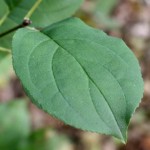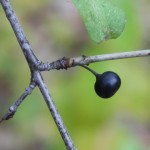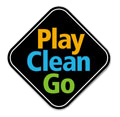The cooler temperatures of fall make it a great season to work on removing buckthorn. Many of our native trees and shrubs change leaf color and begin dropping their leaves in fall. This provides the buckthorn novice with better odds to correctly identify buckthorn compared to the valuable native trees and shrubs we want to keep and protect.
If you would like to improve your ability to confidently identify buckthorn, use these key common buckthorn leaf characteristics:
1. Notice the indented mid-vein of the buckthorn leaf which runs from the leaf bottom to the leaf tip. Common buckthorn (Rhamnus cathartica) will have 3 or 4 upward curving veins on each side of the mid-vein. This is the most important feature to find but must be combined with the following additional leaf characteristics.
2. The leaf shape is typically a oval – wider across the leaf center.
3. The leaf margin or edges of the leaf are slightly serrated or toothed.
4. The leaf remains green in the fall.
Common buckthorn berries are only found on mature female buckthorn plants and will look like this in the fall:
Copyright 2012 Landscape Restoration, Inc. “Common Buckthorn Berry”
1. Berries of common buckthorn become purple to purple-black in late summer to early fall. Each berry contain 3 to 4 seeds which remain viable in the soil for at least 5 years after dropping from the buckthorn plant or birds who eat the berries. Some buckthorn trees produce thousand of berries per season. You can do the math and understand why buckthorn becomes invasive in a short time span and remains a problem even after the mature trees are removed.
2. The stem of each common buckthorn berry attaches directly to the twig. Berries of native species like choke-cherry, black cherry, nannyberry, etc. form a group and this group is then attached to the twig by one stem.
Now that you are on your way to becoming an expert at identifying common buckthorn in the fall, refer to my blog “Buckthorn – is it a Problem on Your Property” dated 2/15/12 too learn about winter bud identification of buckthorn when the leaves are gone.Go outside today and start getting rid of non-native & invasive common buckthorn. Remember to check out our Buckthorn Blaster herbicide applicator product for cut-stump treatment of buckthorn found under the PRODUCTS tab at www.landscape-restoration.com.
Cheryl Jirik
Landscape Restoration, Inc.




